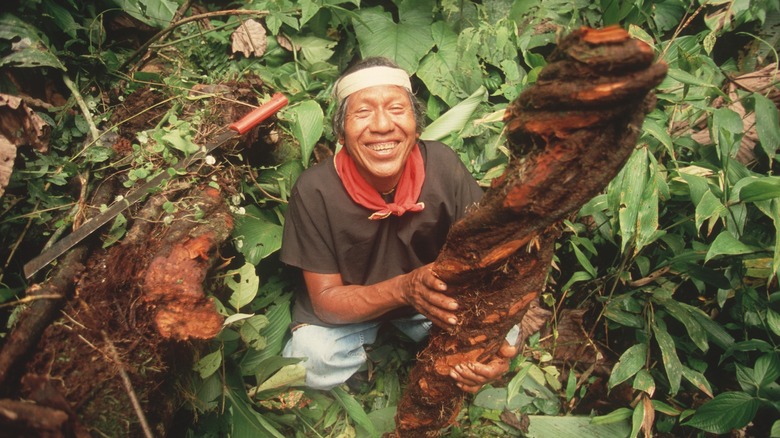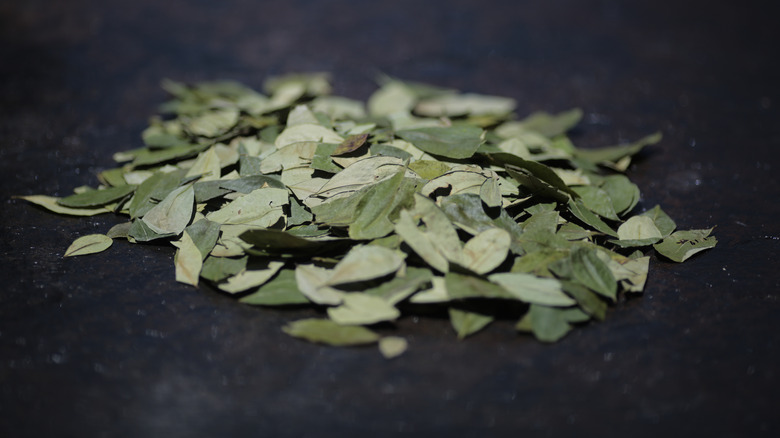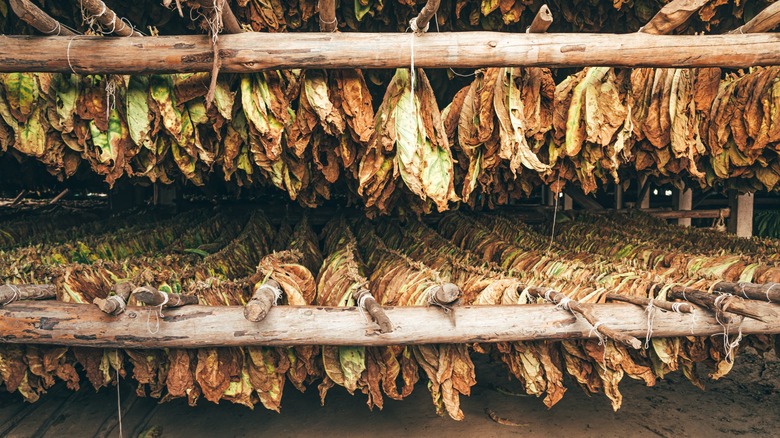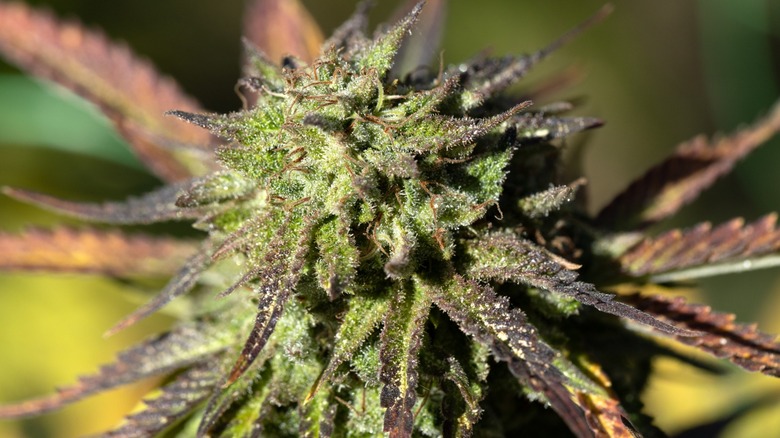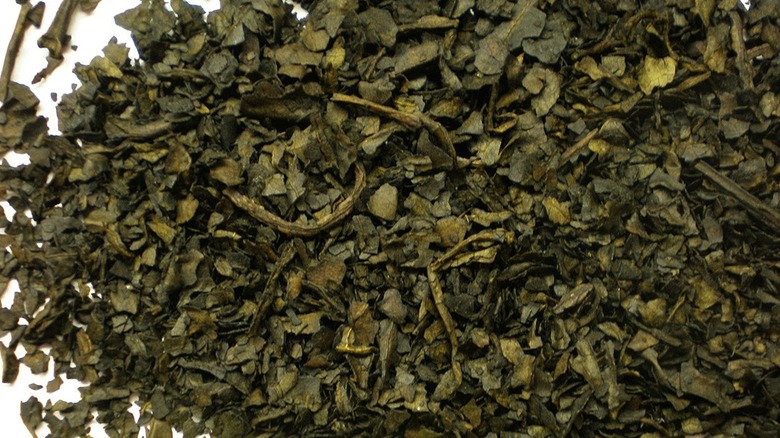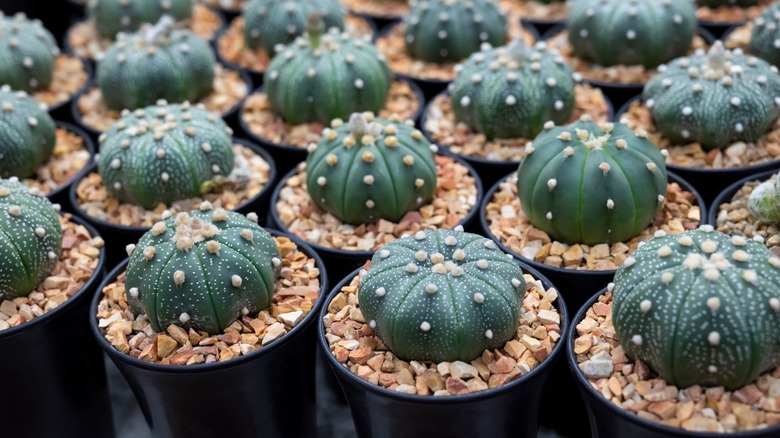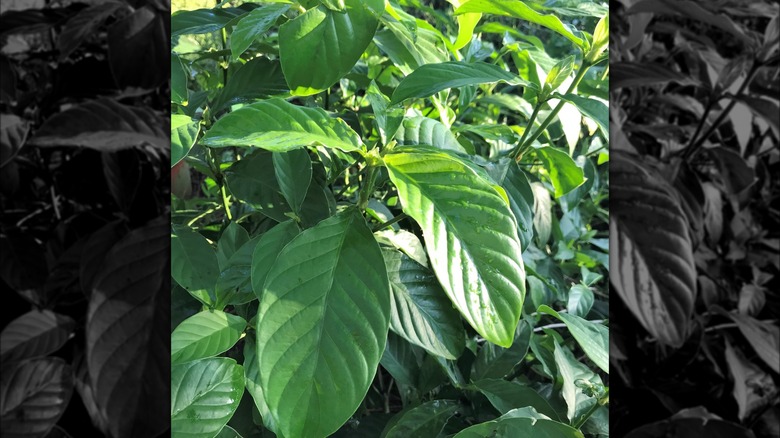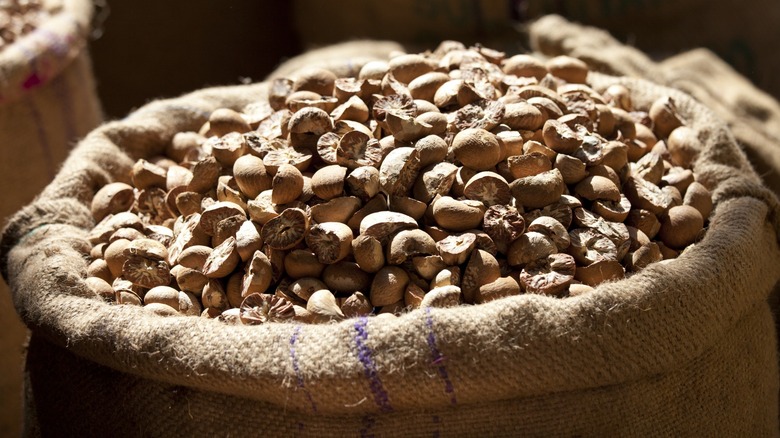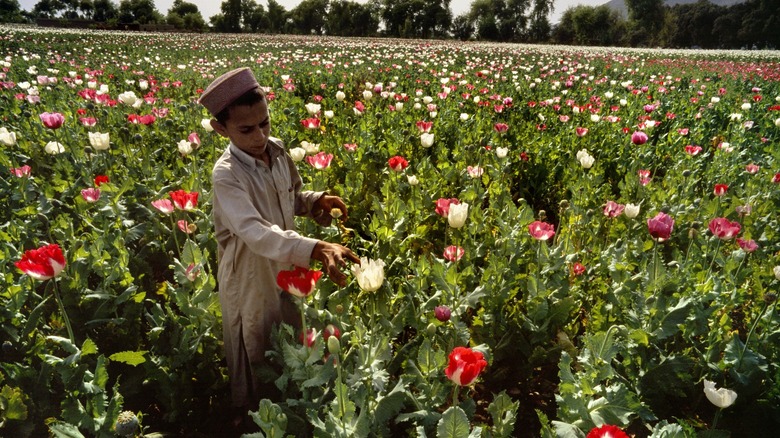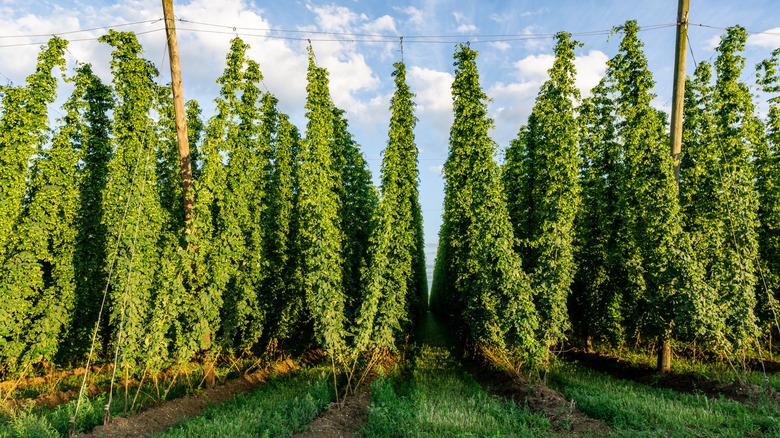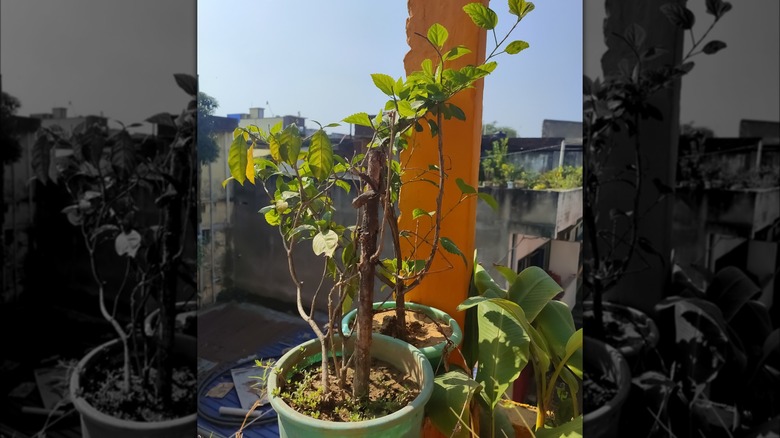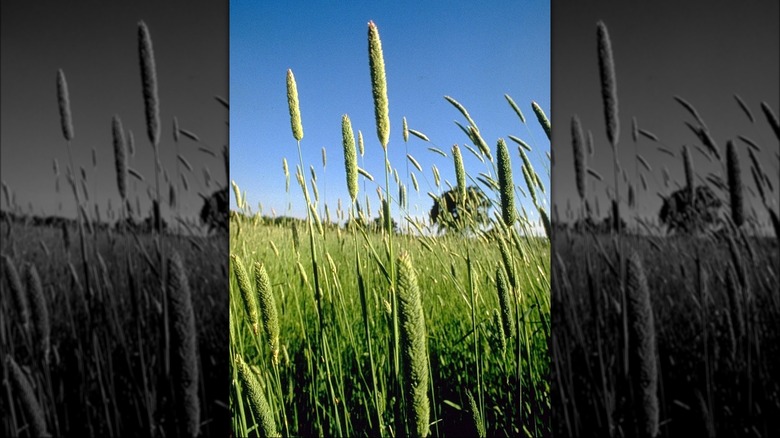12 Psychoactive Plants And What They Do To Your Brain, According To Science
Without plants, it's safe to say that human history would be pretty radically different. Not only have plants helped provide things like basic nutrients to help the human body function, evolve, and survive, but humans have found a myriad of uses for plants over the thousands and thousands of years of their co-existence.
The Ancient Egyptians used the Lavandula or lavender plant to scent perfumes and for various ointments, and the Ancient Romans included the salvia officinalis or sage plant into their hair care routines, as well as in various medicines for many different ailments. The first known use of plants by humans for their intoxicating and psychoactive properties dates back to 13,000 years in the Levant, when the Natufian civilization made alcoholic beer from a combination of seven different plants. Psychoactive plants are those that affect the mind if they are properly ingested, and depending on the specific plant, their psychoactive properties induce unique responses in the brain.
For the most part, psychoactive plants contain chemicals that affect different neurotransmitters like serotonin, dopamine, and cannabinoid receptors, which are responsible for things like stimulation, sedation, altered moods, and even hallucinations. Today, plants still play a crucial role in many people's lives, and people use their psychoactive properties for both recreational and medicinal reasons.
If you or anyone you know needs help with addiction issues, help is available. Visit the Substance Abuse and Mental Health Services Administration website or contact SAMHSA's National Helpline at 1-800-662-HELP (4357).
Coca
The Erythroxylum Coca shrub, or as it's more commonly known the coca plant, is one of the more famous — or infamous — plants associated with human history. Cocaine is the relevant psychoactive drug in coca, and it is found in the plant's leaves. As the Encyclopedia of the Neurological Sciences states, cocaine works on several of the brain's neurotransmitters like dopamine and serotonin. By stimulating these neurotransmitters, users of cocaine experience feelings of euphoria and increased energy, as well as less appealing side effects like a loss of appetite and at times severe paranoia and anxiety.
The plant causes the brain to release large and unregulated amounts of dopamine, which is largely responsible for the feelings of euphoria and happiness, by bypassing the brain's natural dopamine-shut-off system. However, cocaine can also change brain chemistry over time to become psychologically addicting, and it has a myriad of negative effects on the cardiac system from the increased stimulation. For developing fetuses who are exposed to cocaine in the womb, it can also inhibit their brain development and growth as a side effect.
The coca plant is indigenous to areas of South America, especially the mountainous Andes region and the northwestern coast from Peru to Venezuela. Today, most people associate the coca plant with its modern derivative product cocaine. Yet, according to some researchers, humans started using the unprocessed leaves of the coca plant combined with lime powder for its psychoactive effects as far back as 10,800 years ago.
Tobacco
Of all the psychoactive plants on earth, tobacco is definitely one of the most popular and widely used in modern human history. Tobacco contains the psychoactive drug known as nicotine, which is extremely addictive for the user. There are two primary types of tobacco that growers plant today for their nicotine content, Nicotiana Tabacum and Nicotiana Rustica, and they are from the Solanaceae or nightshade family of plants. The most popular ingestion methods of tobacco are smoking the dried leaves as cigarettes, sniffing the leaves as snuff, or using chewing tobacco.
Inside the brain, nicotine primarily affects the nicotinic acetylcholine receptors (nAChRs), which are responsible for controlling neurotransmitters like acetylcholine, dopamine, and serotonin. Nicotine makes its way to the brain as quickly as 10 seconds after inhalation when smoking, and users report experiencing feelings like relaxation and increased focus, which scientists think is due to the acetylcholine reaction.
In addition, it might sound surprising, but nicotine can actually enhance cognitive function related to things like working memory and fine motor skills. This is why it can be so hard for users to quit, as the withdrawal from nicotine causes them to experience a feeling of cognitive decline, which can only be rectified by more nicotine. Unfortunately, there is also strong evidence that adolescent smokers are more likely to develop psychiatric and cognitive defects when they get older from nicotine's effect on the brain (via Cold Spring Harbor Perspectives in Medicine).
Marijuana
The term marijuana generally refers to the psychoactive cannabis plant, of which there are three recognized species: Cannabis Sativa, Cannabis Indica, and Cannabis Rudeleris. However, only cannabis plants that have a significant amount of the psychoactive drug delta-9-tetrahydrocannabinol, or THC, are considered marijuana, and non-psychoactive cannabis is known as hemp.
THC works on the brain by affecting cannabinoid receptors in the endocannabinoid system (ECS), which scientists only discovered the existence of in the 1980s. The ECS is what controls things in the brain like memory, learning, and even pain control, and there are cannabinoid receptors throughout the brain that control things relating to appetite, learning, motor control, coordination, emotions, and fear. The body normally produces and uses the chemical Anandamide to regulate the ECS, but when people ingest THC, the THC instead replaces the Anandamide and starts making users experience feelings of relaxation and sedation, visual hallucinations and anxiety, and a distorted sense of time and reality. In addition, THC also leads to a rapid release of dopamine at high levels, which can make users feel euphoric.
There is evidence suggesting that humans as far back as 2,500 B.C. in central Asia burned marijuana, potentially for its mind-altering effects. However, marijuana users are more at risk for psychiatric disorders like schizophrenia, and it can also exacerbate symptoms of bipolar disorder. Interestingly, though, marijuana can also help those already diagnosed with schizophrenia with some learning and memory tasks.
Salvia
For hundreds of years, humans have used the Salvia Divinorum plant for religious, spiritual, and medical reasons. The plant is native to Oaxaca, Mexico in the Sierra Madre Oriental mountain range, where for many years the only users were the indigenous Mazatec people. Since the mid-20th century, its use has spread throughout the world, and it is a popular recreational drug today. Users of Salvia ingest the plant through smoking or otherwise orally consuming the leaves, and they report vivid visual hallucinations fierce enough to cause out-of-body experiences as well as synesthesia– or experiencing multiple senses at once, like the ability to feel sound. The "high" from Salvia only lasts a maximum of about 20 minutes but is noted for being extremely intense.
The psychoactive compound inside Salvia is known as Salvinorin-A. Salvinorin-A targets the kappa-opioid receptor (KOR) in the brain, and scientists think the powerful reactions are related to its high dosage and unique KOR interaction (via the International Journal of Neuropsychopharmacology). This is different than other common hallucinogens, like LSD and psilocybin, which target different serotonin receptors to produce their effects. Salvinorin-A's interaction with the KOR is much different and is the only known substance to act this way, except possibly Ibogaine. Additionally, Salvinorin-A also produces strong dissociative feelings in users.
Salvia is not thought to be linked to substance use disorders according to current criteria or many adverse health effects. Still, many users have wound up in the emergency room after particularly intense experiences or "trips."
Peyote
Peyote, or Lophophora Williamsii, is probably the most famous cactus in the world. The peyote cactus has been associated with human use for at least 5,700 years, and Native Americans in what are today the southwestern United States and northern Mexico used it for spiritual, religious, and medicinal purposes starting around 3,000 years ago. For the most part, people consume bitter-tasting buttons from the crown of the peyote cactus, which contains the psychoactive drug known as mescaline.
Mescaline is a psychedelic hallucinogen that activates both serotonin and dopamine receptors in the brain (via the Encyclopedia of Toxicology, Vol. 3). However, exactly how the stimulation of these receptors leads to mescaline's apparent psychedelic effects is not well understood. The main actors that mescaline affects are the 5-HT2A and 5-HT2C serotonin receptors, with the former being responsible for the hallucinations.
It only takes about 300-500 milligrams to produce a response, which means eating about 7 to 11 buttons, and the psychoactive effects begin to start about an hour following ingestion. Compared with other psychedelics, users describe peyote experiences as having distinctive feelings characterized by hypersensitivity to sound as well as pitch distortion and intensified synesthesia. The Lophophora Williamsii is not the only cactus that contains mescaline, there are several others in the Americas that people can harvest for the drug.
Psychotria Viridis
While most people probably do not recognize the Psychotria Viridis bush native to the Amazon Rainforest, some of them may be familiar with its potent psychoactive drug known as DMT. For thousands of years, Shamans in the Amazon have been combining the Psychotria Viridis bush with the Banisteriopsis Caapi vine to create the psychedelic concoction widely known as Ayahuasca. Shamans use Ayahuasca in ceremonies celebrating everything from the spiritual and religious to the medicinal.
Like other psychedelics such as mescaline, DMT targets the 5-HT2A, 5-HT2C, and 5-HT1C serotonin receptors in the brain to produce its hallucinogenic effects (via Theresa M. Carbonaro in "Neuropharmacology of N,N-Dimethyltryptamine"). It also stimulates other neurotransmitters, like dopamine and acetylcholine, but it largely works by activating the 5-HT serotonin response. Unlike other psychedelics, DMT is not orally active by itself. That's why Shamans use the caapi vine, because the vine contains specific alkaloids that stop the body from destroying the DMT as it is digested, allowing it to work. In addition to DMT, Ayahuasca also contains the drugs 5-MeO-DMT and 5-OH-DMT, which also target the same neurotransmitters and produce similar hallucinogenic effects.
Another interesting facet of DMT is that it is found naturally occurring in the human brain in low concentrations, but scientists have little idea how it works. Some speculate that its release may play a part in how the mind perceives altered states of consciousness, like dreaming or near-death experiences, but that is far from conclusive and only speculative.
Betel Nut
While it is not very popular in the United States, worldwide, the betel nut is one of the most commonly used psychoactive drugs available. The betel nut is a seed that is indigenous to southeast Asia, and it comes from the Areca Catechu or palm tree. To ingest the betel nut, users will chew it after it has been boiled and wrapped in betel pepper leaf, and it gives off feelings of euphoria, heightened awareness, and overall mental stimulation.
All four of the most prominent psychoactive alkaloids in the betel nut, arecoline, arecaidine, guvacoline, and guvacine, contribute to its stimulating properties by interacting with the brain's gamma-aminobutyric acid (GABA) receptors (via the Indian Journal of Medical and Paediatric Oncology). GABA receptors help calm and de-stress the mind, and by suppressing them the alkaloids can cause feelings of happiness and excitement. In addition, betel also raises the noradrenaline and adrenaline concentrations in the brain, which is what accounts for some of its uplifting effects on mood, arousal, and alertness (via Addiction Biology).
In many ways, betel is comparable to nicotine due to its highly addictive nature and mild stimulating and euphoric effects. Betel nut use is most prominent in areas of Southeast Asia like India, Sri Lanka, and the Philippines, but immigrants have brought the tradition to the United States, where the betel nut is largely unregulated.
Opium Poppy
As the precursor to some of the world's most widely used licit and illicit substances, the opium poppy has a pretty controversial reputation. While it is helpful in many medications, it is also very mentally and physically addictive. There are both naturally derived opiates, like heroin and oxycodone, and synthetically derived opiates, like fentanyl and methadone, and the synthetic opiates can be much more powerful on the brain.
The scientific name for the opium poppy is Papaver Somniferum, and though it originated in Asia, people now cultivate it worldwide. The two biggest psychoactive drugs in the opium poppy are morphine and codeine, both of which have extreme suppressive effects. There are distinct opioid receptors throughout the body, mainly in the brain and spinal cord, which opiates interact with. These receptors work by reducing the amount of pain the user feels, and they also slow breathing and curb coughing. In addition, many users also experience euphoria and an altered state of consciousness that some describe as dreamlike.
Some of the opioid receptors, specifically the mu-opioid receptors, are associated with the brain's reward system, and they release dopamine to reinforce positive life behaviors, like eating (via Addiction Science and Clinical Practice). This can lead to addictive behaviors associated with opiates, as taking them can stimulate these receptors, causing the brain to associate good feelings with opiate intoxication and develop a dependence. In addition, prolonged usage can change the brain so that it needs a continued opiate supply to retain normal function.
Hops
While it's easy to associate alcohol with the mind-altering effects of drinking beer, the hops plant also plays an important role in its intoxicating properties, too. There are two types of hop plants, the Humulus Lupulus or common hop, and the Humulus Japonicus or Japanese hop, and brewers use the common hop to make their beers. Using hops helps to enhance the taste, flavor, smell, and freshness of beer, and it belongs to the same plant family (Cannabaceae) as marijuana. All beer contains hops or it is not considered beer.
The psychoactive effects of hops on the brain are primarily sedative. As hops are brewed, some of the compounds begin to break down due to oxidation. These compounds combine with natural bitter resins in the hops to stimulate the Gamma-Aminobutyric Acid (GABA) neurotransmitter in the brain. The GABA neurotransmitters help to decrease nerve stimulation, so they are associated with feeling calm and relieving stress and anxiety. By activating the GABA neurotransmitters, hops produce a sleepy feeling in drinkers, which is enhanced by its increased production of the hormone melatonin, which is also associated with sleep.
Cultivators grow hops around the world from the United States to Eastern Europe and Asia, and humans have been using them in brewing for at least 1,200 years. While alcohol is the biggest intoxicant, hops still play an important psychoactive role, and without them, there would be no such thing as real beer.
Iboga
The Iboga plant, or Tabernanthe Iboga, is a very unique shrub, in that consuming it produces both intoxicating and anti-addictive feelings in the user. The Iboga plant is indigenous to West Central Africa, and its important psychoactive drug is called Ibogaine. Users who ingest Ibogaine report having hallucinations similar to psychedelic drugs like LSD. Though scientists are not entirely certain, they think that the hallucinogenic properties are related to Ibogaine's interaction with the kappa-opioid (KOR) and 5-HT2A receptors in the brain, which is also how other hallucinogens like salvia and Mescaline work (via "Progress in Brain Research: Psychedelic Neuroscience").
However, what makes Iboga unique among all of these is that it also seems to impart anti-addictive emotions to some users, though scientists are still debating why. Some suggest that the intake of ibogaine reduces dopamine levels in the brain and that it can also reverse neuropathways relating to addiction, leaving them in a "pre-addiction condition." This means that users' brains won't default to wanting and relying on drugs to function, because newly developed neuropathways will push them in different directions.
Many users report that after an Ibogaine trip or experience, their affinity for wanting to use other drugs decreases, sometimes for several months. This is reinforced by some animal studies showing similar reactions towards cocaine and opiates after ingesting Ibogaine, too (via Brain Research Bulletin). While it's far too early to call ibogaine any sort of addiction cure, it certainly has some interesting properties.
Canary Grass
Canary Grass, or Phalaris Aquatica, might not seem like your average psychoactive plant, but it's actually loaded with various hallucinogenic compounds. Getting high on Canary Grass is called "canary grass intoxication," and it's known to be used by both humans and animals, though it can be fatal to the latter. Among the other drugs, Canary Grass contains DMT, 5-MeO-DMT, and bufotenine (5-OH-DMT), all of which produce hallucinations when ingested properly (via "Neuropathology of Drug Addictions and Substance Misuse, Volume 2").
DMT is the same active ingredient found in psychedelic drugs like Ayahuasca, and it stimulates the 5-HT serotonin receptors to produce its effects. The other substances, 5-MeO-DMT and bufotenine, are both similar to each other and to DMT in how they interact with the brain and make the user feel. The first, 5-MeO-DMT, actually produces more vivid hallucinations than DMT according to some users, because it attaches better to the specific 5-HT1A receptor. Bufotenine users report its effects are similar to hallucinogens like LSD or magic mushrooms, but it is also associated with schizophrenia and other psychological disorders, though there is no definitive link
The only other plant similar to Canary Grass is the plant-concoction known as Ayahuasca, as it also contains the same three compounds. Canary Grass is a type of moss, and people now grow it everywhere from the Mediterranean to the United States.
